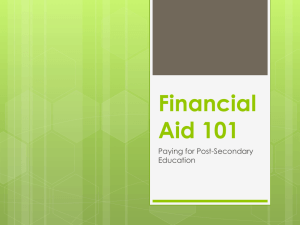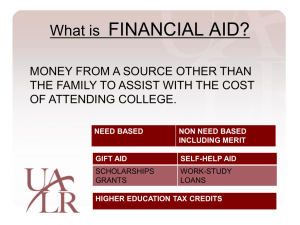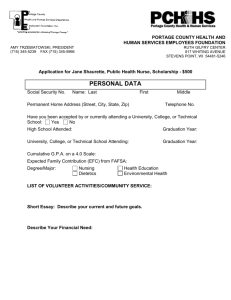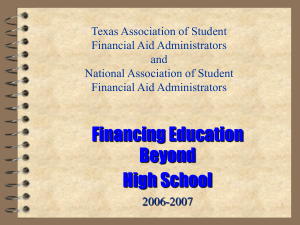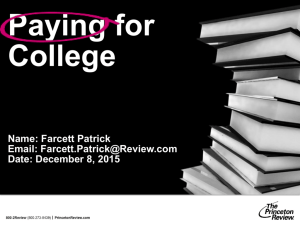College Financial Aid Night
advertisement
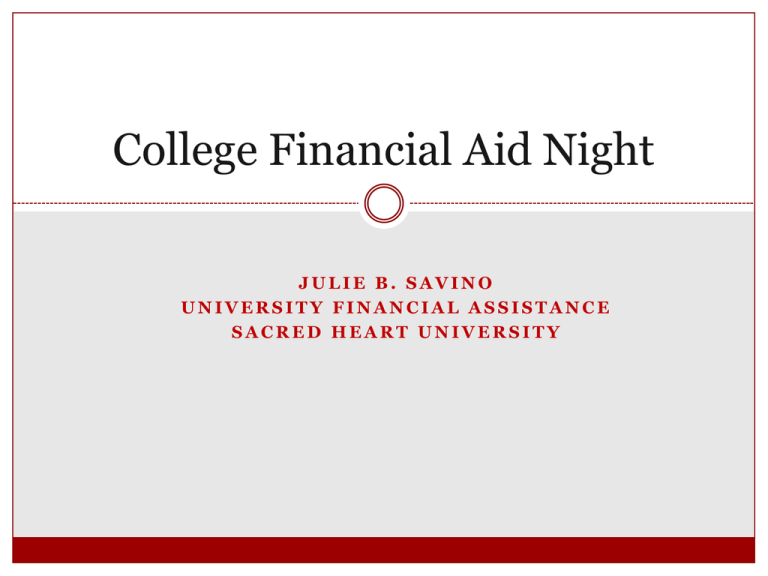
College Financial Aid Night JULIE B. SAVINO UNIVERSITY FINANCIAL ASSISTANCE SACRED HEART UNIVERSITY College Financial Aid Night For Students, the scariest part is getting into the college of their choice. For their Parent, the scariest part is paying for it!!! Tonight’s Agenda And….. To Dispel Financial Aid Myths A discussion of : Sources and Types of Financial Aid Application Process Determining Eligibility Thoughts and Tips The Cost of Higher Education Myth The published cost represents the true cost. In Actuality What really matter is the amount the student will pay. It’s the net price! Net Price by Income 1999-2012: Public Four-Year Institutions College Board Trends in College Pricing, 2012 Net Price by Private Institutions College Board Trends in College Pricing, 2012 Net Price Calculator Federal mandate intended to help students and their families manage financial expectations. Institutions all have their own versions! Online device offering customized approximations of college costs based on: Standard inputs of family size, income, savings, etc. Calculator estimates a prospective student’s aid Subtracts that from a college’s list price And spits out a “net price”. Wide variation -- financial aid is as much art as science! While the tool is to be approachable and accurate, the output will be more predictive as the student gets closer to the application stage. Who Qualifies for Financial Aid? Myth Only low-income families qualify for financial aid. Truth The EFC should be less than the cost of attendance for a student to qualify for need-based aid. Who Qualifies for Financial Aid? Principles of Financial Aid Parents and students are primarily responsible for financing an education. Sacrifice is assumed. Financial aid assessment is an evaluation of economic strength, not cash flow. The family contribution is standardized calculation that assesses ability to pay, not a willingness to pay. Financial aid is a supplement whose intent is for student access and choice. Types of Financial Aid Grants Scholarships Work-Study Programs Loans Many organizations do not exhaust scholarships every year because students do not apply for them! 2013-2014 $184.1 Billion For Undergraduate Students Source of Information: The College Board “Trends in Student Aid 2014” To learn more visit: https://trends.collegeboard.org/ Student Debt is at Mortgage Levels Myth Student Debt is at a crisis level. Students borrow over $100,000 in student loans. In Actuality More students are going to college and therefore, more students are borrowing. Only 4% of students with outstanding student debt owe $100,000 or more. Most had pursued advanced degrees! Student Debt Levels Source: Federal Reserve Bank of New York, The College Board Trends in Student Aid 2014 Student Debt Levels Source: Federal Reserve Bank of New York, The College Board Trends in Student Aid 2014 Who Can Get Financial Aid? For Federal Assistance, and in general ……. U.S. citizen or permanent resident High school graduate/GED holder Enrolled in an eligible degree/certificate program Valid Social Security number Males registered for Selective Service Satisfactory academic progress States, colleges, and private scholarships have their own eligibility criteria. Be sure you know what you need to do to qualify. Do You Want to Be Considered Financial Aid? The FATAL Mistakes DEADLINES missing application dates missing admission dates missing information Do You Want to Be Considered Financial Aid? For students to be considered for financial aid — money given or loaned to help pay for college — you have to apply. Applying for financial aid is like applying for admission to college, but they’re not the same thing. The financial aid application process usually has its own forms, deadlines and requirements — and you don’t have to wait to be admitted to a college before you apply for financial aid. Do You Want to Be Considered Financial Aid? Check with College and Universities …. 1. What Financial Aid Applications are required? 2. What are the financial aid deadline dates? Submit required information at least two weeks before earliest deadline. For example; Deadline February 15th -- Submit by February 1st. Common Financial Aid Applications Free Application for Federal Student Aid (FAFSA) Required for all types of aid www.fafsa.ed.gov Profile Application (CSS Profile) Used primarily by private colleges. https://profileonline.collegeboard.com Institutional Applications Check school publications and websites Federal Student Aid Process Federal Student Aid Programs Applying for College Applying for Financial Aid My FSA High school juniors can take advantage of FAFSA4caster web site and learn about the process, gain early awareness of aid eligibility and much more. www.studentaid.ed.gov Federal Student Aid Login – “New” No more PIN! Students now create a FSA ID Yes, Parents too create their own FSA ID Used for FAFSA application Import your tax information from the IRS Used for student and parent loans https://fsaid.ed.gov Federal Application Process The FAFSA is: Required by all schools administering Federal Student Aid Data collection vehicle that supports Federal Methodology (FM) Cannot be submitted until after January 1, but get organized as soon as possible Get worksheet at www.studentaid.ed.gov/ worksheet https://fafsa.ed.gov/ Federal Application Process The FAFSA is: Required by all schools administering Federal Student Aid Data collection vehicle that supports Federal Methodology (FM) Cannot be submitted until after January 1, but get organized as soon as possible Get worksheet at www.studentaid.ed.gov/ worksheet https://fafsa.ed.gov/ Federal Application Process Complete the FAFSA IRS Data Retrieval Tool offered for ease and accuracy. Use to import data for initial application or update application at a later date. Review the FAFSA results through the Student Aid Report Applicants receive an email with a link to access the SAR. Correct your FAFSA, if necessary Review all messages Your may find messages selecting for review which may require you to submit various forms of documentation to the school. Schools receive applicant data electronically May offer tentative award based on current information May verify or adjust information – upfront or later CSS Profile Application Process The College Board CSS Profile collects more comprehensive family and financial information Supports Institutional Methodology (IM) Allows schools to receive information earlier in the cycle College and programs rely on Profile data to award nonfederal funds Remember to check for other institution specific forms! https://student.collegeboard.org/cssfinancial-aid-profile What’s Next Determining Eligibility Cost of Attendance - Expected Family Contribution ____________ ____________ = Financial Need The Cost of Education Direct Costs Tuition and required fees Room and board for resident students Indirect Costs Books and supplies Transportation to and from campus Miscellaneous personal expenses Direct Costs Indirect Costs Total Cost of Education What is the Expected Family Contribution – EFC? The EFC is a measure of capacity over time to absorb educational costs Not a dollar amount expected from current income or assets Not an estimate of extra cash available Not the same as the student’s bill or the amount a family will actually pay to attend college. Federal EFC is used as an ELIGIBILITY INDEX for federal aid purposes. EFC determines student eligibility for the Pell Grant and other forms of federal aid and state aid. Schools use an EFC (Federal and/or Institutional) and cost of education to put together a “package” of financial assistance. The EFC is subject to school verification and adjustments. Elements of Need Analysis The Financial Aid Funnel # in family FAFSA Income # in college Uses both parent and student information (dependent students) Parent’s income is the major determinant Uses standard income and asset protections allowance Parents’ assets range from 2% to 6% of total Students’ assets range from 25% to 35% of total FM EFC Federal Methodology (FM) does not consider Home Equity or Qualified Retirement Assets Elements of Need Analysis The Financial Aid Funnel Institutional Methodology (IM) treats income and assets differently than FM Home Equity Medical Profile Allowances Typically uses home equity Protection for emergencies Protection for college savings May allow for medical expenses May adjust for regional cost of living Institutional options! IM EFC It is OK to estimate! Financial Aid Notification A financial aid award notification is a communication from a college that states the type and amount of financial aid the student is eligible to receive if the students enrolls at the institution. Need-Based vs. Merit Based Need-based aid is dependent on a family’s EFC. Merit-based aid is an award considering achievement, talent, participation …. not exclusively based on family’s EFC. NeedBased Aid MeritBased Aid Pell Grant Academic Achievement Work Study Athletic Achievement Eligibility for Financial Aid 4 Year Private 4 Year Public Total Cost $42,000 $19,000 - FM EFC $15,000 $15,000 = Eligibility $27,000 $4,000 The Financial Aid Package Total Cost = $42,000 Total Cost = $42,000 Unmet Need: Scholarship/Grant: $19,000 $4,000 Scholarship/Grant: $15,000 Work $2,500 Work $2,500 Loan: $5,500 Loan: $5,500 EFC: $15,000 EFC: $15,000 The Financial Aid Package Total Cost = $42,000 Unmet Need: Total Cost = $42,000 $4,000 EFC after Merit: $12,000 Scholarship/Grant: $15,000 Work: $2,500 Loan: $5,500 EFC: $15,000 Academic: $15,000 Athletic: $15,000 Financial Aid Reality Total Cost of Education (minus) - Aid Awarded (equals) = Family Share Finding the Family Share Income Loan Savings Finding the Family Share Ask people if they know of any private scholarships you could apply for – employer, guidance office, faith based organizations, clubs family may belong to and local library. Do research on the web. There are many free, quality websites for scholarship searches. Be imaginative! Families should save as much as they can – no amount is too small! Sign up for monthly payment plan through the institution, generally will allow you to pay the remaining balance over 10 months. If you find it difficult to pay within a 10 month period, research long-term financing options. Federal Parent Loan (Plus) Connecticut Family Education Loan Program (CHESLA) Private Alternative Loan for Education Personal Family Options State of Connecticut Programs http://www.ctohe.org/sfa Governor's Scholarship CT Minority Teacher Incentive Grant/Weisman Teacher Scholarship English Language Learner Educator Incentive Program Veterans Benefits CHESLA Loan Program The Connecticut Higher Education Supplemental Loan Authority. Provider of the Connecticut Family Education Loan Program (CHESLA). www.chesla.org Top 5 Things to Consider! 1. Never rule out a college because of cost alone. 2. Compare costs before applying — Net price calculators can provide an estimate of financial aid eligibility and remaining college costs. Net price calculators should be available on every college's website. 3. Remember to apply — FAFSA deadlines are available online at https://fafsa.ed.gov/deadlines.htm. Many colleges and universities also provide funds through an institutional application, the CSS/Financial Aid PROFILE® and/or a state application. 4. Get advice — The financial aid office at the college or universities you are applying provide workshops or can give advice. 5. Compare awards — Look at scholarships, grants, loans, and parental contributions before making a final decision on a college. Questions to ask and not assume! How do outside awards affect the aid package? What is the school’s policy on non-custodial parents? What is the median student debt level? Are the scholarships/grants renewable each year? Does the college have a “need-blind” or “need- sensitive” admissions policy? How might awards change in future years? Final Thoughts … Many factors involved in the awarding of aid result in different financial aid packages from different schools. Consider a financial “safety” school. The best deal is not always the best fit! Consider all types of aid … particularly when it comes to educational loans. Look at all financing options – start with those suggested by the college at which the student enrolls. Financing plans should cover 4 years. Appeal if circumstances change. Spend time with scholarship and grant search tools – they make a difference! Where There’s “The Web”, There’s a Way www. nces.ed.gov/collegenavigator National Center for Education helps you prepare for your education beyond high school, build a list of schools using My Favorites for side-byside comparisons, apply for financial aid and even help plan a career. www.college.gov A site designed by the U.S. Department of Education in collaboration with students to help students make the dream of college a reality. www.ed.gov The agency of the federal government that establishes policy for, administers, and coordinates most federal assistance to education. The site provides information about the popular Student Guide to Financial Aid and how to apply online to federal programs. www.sss.gov The Selective Service Registration allows students to check registration and register for Selective Service. www.gibill.va.gov GI Bill. Department of Veteran’s Affairs provides information on the Post-9/11 www.nslds.ed.gov student loans. National Student Loan Data System allows students to track their . Where There’s “The Web”, There’s a Way www.ctohe.org The Connecticut State Higher Education website for state financial aid programs and links to Connecticut colleges and universities. www.chesla.org The Connecticut Higher Education Supplemental Loan Authority. Provider of the Connecticut Family Education Loan Program (CHESLA). www.collegeboard.com Use the College Board’s College Financing Calculators to help you figure out how to pay for college and information on scholarships. www.nasfaa.org Consumer tips for parents and students as well as financial aid tools for completing required applications. www.finaid.org Financial Aid Information Page. Lists a variety of financial aid information, including family contribution calculators. www.ftc.gov Federal Trade Commission protects America's consumers by providing information on scholarship scams and how to avoid them. Where There’s “The Web”, There’s a Way www.fastweb.com FastWEB a highly popular, customized financial aid scholarship matching service from a database of 1.5 million scholarships. https://bigfuture.collegeboard.org/scholarship-search By The College Board. Find scholarships, other financial aid and internships from more than 2200 programs totaling nearly $ 6 million. https://mycollegedollars.hyfnrsx1.com can be accessed through FaceBook. www.scholarships.com Free scholarship search www.scholarshipamerica.org Dollars for Scholars chapters of Scholarship America mobilizes support for students getting into and graduating from college. It is a national organization that has helped more than 1.7 million students follow their dream of getting to college. www.asfdn.org American Savings Foundation is an independent charitable foundation dedicated to strengthening the community by supporting education, human services, and the arts, with a special emphasis on the needs of children, youth, and families through grants to community organizations and college scholarships. www.studentlendinganalytics.com Student Lending Analytics lists private loan options for undergraduates to serve schools and their students who need a focused and neutral resource for help in finding a private student loan. /
